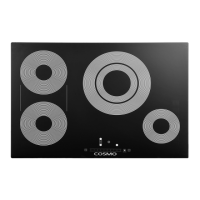33
• Never cook directly on the glass. Always use cookware.
• Do not use the glass cooktop surface as a cutting board.
• Do not place any cookware, utensils, or leave excess water spills on
control key pads. This may result in unresponsive touch pads and
turning off the cooktop if present for several seconds.
• Do not slide metal or glass across the cooktop surface. Cookware with
rough or uneven bottoms can mark or scratch the cooktop surface.
• Do not place sealed containers on the cooktop.
• Do not place aluminum foil or plastic items such as salt and pepper
shakers, spoon holders, or plastic wrappings or any other material on
the cooktop when it is in use.
• Do not turn surface units on before placing cookware.
• Always turn the surface units off before removing cookware.
• The surface element may appear to have cooled after it has been
turned off. The element may still be hot and touching the element
before it has cooled sufficiently can cause burns.
• Only certain types of glass, glass-ceramic, ceramic, earthenware, or
other glazed cookware are suitable for cooktop service without
breaking due to the sudden change in temperature.
• Choose proper heating element size. For smaller pots and pans, use the
smaller heating elements. For larger pots and pans, use the larger
heating elements. Select pans that have flat bottoms large enough to
cover the heating elements. Using undersized pans exposes a portion of
the heating element to direct contact and may result in clothing
burning.
• Immediately clean spills on the cooking area to prevent a tough
cleaning chore later.
• Do not use a steel-wool pad or scrub pad or abrasive cleaning pads.
They can scratch the surface.
CAUTION

